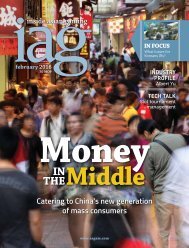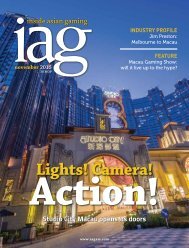Create successful ePaper yourself
Turn your PDF publications into a flip-book with our unique Google optimized e-Paper software.
Tech Talk<br />
“The Louisenthal facility is nestled<br />
in the Bavarian countryside an hour’s<br />
drive south of Munich”<br />
A particularly memorable seminar session – featuring Marc<br />
Mittelstaedt, G&D’s head of banknote design – provided a layer-bylayer<br />
exposition of the creation of a new banknote. As G&D points<br />
out in its promotional literature, banknotes are an expression<br />
of the identity of a nation, serving in a way as calling cards.<br />
The creation of banknotes is therefore a complex art, melding<br />
aesthetics and the latest advances in security technology. To<br />
illustrate the various steps in the process, Mr Mittelstaedt’s team<br />
designed and produced a colorful sample banknote — after the<br />
Bauhaus-style, the influential art school that played an important<br />
role in Western architecture in the 20th century — incorporating<br />
all the latest security features.<br />
The base layer consists of the banknote substrate. Banknote<br />
substrates incorporate several embedded components such as<br />
watermarks, which have been an important security feature for over<br />
100 years, as well as security threads.<br />
Adjusting for differing climactic and circulation conditions across<br />
countries, G&D treats substrates with special coatings before and<br />
after printing to maximize the durability of banknotes within their<br />
given environment, while ensuring the security features are not<br />
compromised in the process.<br />
The next step involves printing of the background using a<br />
simultaneous offset method that makes possible security features<br />
such as see-through registers and intricate, multi-colored designs.<br />
Additional invisible but multicolor luminescent motifs, which appear<br />
under UV light, may also be included.<br />
Then comes a layer of intaglio printing, a technique whereby an<br />
image is engraved into a metallic printing plate, and the incised line<br />
or sunken area holds the ink. This gives banknotes their unique strong<br />
colors and contrasts, the tactile texture and high-quality appearance.<br />
The final stages involve screen printing and numbering. Screen<br />
printing is used to apply layers of newly developed functional<br />
pigments that can produce striking dynamic effects. Furthermore,<br />
the thickness of the coating involved in screen printing produces a<br />
substantial optical brilliance along with a high level of resistance to<br />
wear and tear during circulation.<br />
The all-important sequential serial numbers are added using<br />
letterpress printing. There are various options when it comes to<br />
serial numbers. They can be encrypted or designed to be additionally<br />
machine-readable, using magnetic pigment, for example. In addition<br />
to traditional numbering, G&D has also introduced the laser as a<br />
printing tool, making it possible to integrate the serial number into<br />
the banknote in whole or in part, possibly as a color motif within<br />
the area of the watermark, or a hologram — providing yet another<br />
line of defense against would-be counterfeiters. In the last step of the<br />
cash cycle, banknote processing systems, equipped with high-tech<br />
features such as very sensitive sensors, immediately detect and reject<br />
all counterfeits or banknotes with defects.<br />
22<br />
inside asian gaming <strong>December</strong> <strong>2015</strong>
















